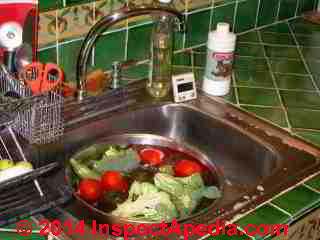 Produce Disinfecting Vegetable Wash
Produce Disinfecting Vegetable Wash
Which home methods for washing vegetables provide effective disinfections?
- POST a QUESTION or COMMENT about the limitations of reliance only on disinfection to make drinking water potable or safe.
Disinfect vegetables, fruits, salads & other produce in the home: this article describes the use of several approaches to washing & disinfecting produce: salad & vegetable products for home consumption.
We include research pointing out which vegetable wash disinfection methods work and might be used successfully in the home and which others must be used with caution, or perhaps not at all.
Interestingly we report that where fruit or vegetable disinfection washes are needed, using distilled water can perform as well as or even better than some store-bought vegetable washes!
InspectAPedia tolerates no conflicts of interest. We have no relationship with advertisers, products, or services discussed at this website.
A Guide to Safe vs Questionable Vegetable Disinfection Washes & Treatments
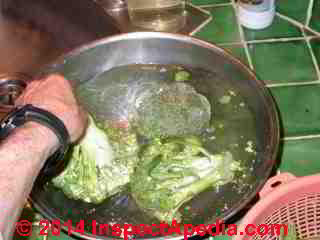 Vegetable disinfecting wash chemicals sold at many produce stores or grocery stores (Sin Bac™, for example, is a product we use in Mexico) often contain a disinfectant that can be used for producing a produce disinfecting wash and that can also be used at a different concentration to disinfect water for drinking.
Vegetable disinfecting wash chemicals sold at many produce stores or grocery stores (Sin Bac™, for example, is a product we use in Mexico) often contain a disinfectant that can be used for producing a produce disinfecting wash and that can also be used at a different concentration to disinfect water for drinking.
We describe how to use SinBac or similar products in detail below.
Watch out: If you have one of these products, read the label for the required amount of chemical to add and the wait time to use before consuming the water.
The Best Way to Wash Raw Fruits & Vegetables
The best ways to keep raw vegetables fruits safe have been outlined by a number of sources (REFERENCES) including both independent organizations (e.g. University of Maine) as well as companies selling vegetable wash products.
The following is adapted & expanded from Bolton (ret. 2014) et als, there are a few basic veggie or fruit washing steps that are key:
- Wash your own hands before preparing food and similarly, keep food work surfaces clean: cutting boards, countertops, etc.
It makes no sense to disinfect your lettuce then cut it atop an infected or bacteria-contaminated cutting board. - Using pre-washed produce:
It is not necessary to wash or re-wash or disinfect produce labeled as "ready to eat" or "washed" or "triple-washed" unless you have placed the produce on an unsanitary surface. - Use cold sanitary tap water water to wash produce where tap water is sanitary.
Technical note: research (REFERENCES) has shown that physically washing fruits and vegetables with clean sanitary water is nearly (95%) as effective as disinfectant washes or soaks.
- Use a disinfecting wash?
The USDA and FDA recommend against using disinfectant washes and or soaks for produce.
Our InspectApedia audience is world wide and includes communities where produce washing or disinfection may indeed be appropriate.
In communities where the sanitation of tap water is uncertain or known to be unreliable and thus where disinfection is appropriate, use one of the types of disinfection products listed below, or consider using distilled water as we discuss below.
- Produce disinfection soak or contact time
Notice the plate in our vegetable wash photo? We make sure that leafy or irregular vegetables or produce such as broccoli remain submerged during the disinfection wash time specified by the product's manufacturer, in this case 5 minutes.
Watch out: the disinfectant contact time needed to be effective depends on the specific disinfectant used and its concentration in water, or its dilution in water and to a degree also on water temperature. The disinfectant contact time needed in any disinfection process also depends on the type of surface and the purpose of the disinfection step.
- Soak irregular-surfaced or rough-surfaced produce (broccoli cauliflower and in our opinion lettuce).
Bolton et als suggest two minutes of soaking in cold clean water, but depending on where you live and where the produce originated, disinfection may be absolutely necessary.
Watch out: some of the vegetable wash disinfection products for sale are ineffective while virtually all of them require attention to the disinfectant concentration and contact time to be effective at all. - Wash lettuce, leafy spinach and similar produce using an appropriate disinfectant (attending concentration & contact time according to the product's instructions) and drain these on a clean dish drainer rack in a clean colander. Remember to wash your salad spinner in soapy water after its use.
We store leafy produce that's not to be used immediately back in the refrigerator. You can preserve the product's crispness by placing a dry paper towel or two in the bottom of the storage bag.
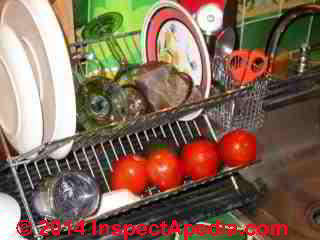
- Use a vegetable brush to scrub thick-skinned produce. Physically cleaning off dirt and debris is as important or more important than chemical disinfection for soiled, dusty, dirty produce.
- Let the produce dry on its own on a clean surface, clean paper towels or a clean dish rack. Don't wipe off the disinfectant.
Bolton et als recommend drying the produce with a paper towel to remove more bacteria, but some vegetable wash disinfectant manufacturers advise air drying which gives increased contact time with the disinfectant.
In our photo (left) we're letting those washed, disinfected tomatos air-dry on a clean metal dish drainer rack. - Once produce has been disinfected, do not wash it again in tap water.
Doing-so removes the disinfectant and in communities where tap water itself may not be sanitary you risk re-infecting the produce. - Keep washed produce refrigerated at 40F or lower.
- Bolton et als recommend that you do not purchase cut produce that has not been kept refrigerated.
- Bolton, Jason, Bushway, Alfred, Crowe, Kristi, El-Begearmi, Mahmoud, "Best Ways to Wash Fruits and Vegetables", Bulletin $4336, University of Maine, retrieved 4/1/14, original source: http://umaine.edu/publications/4336e/
Use of Chlorine-Based (Bleach-based) Hypochlorite Disinfectants for Washing Produce
Above we describe a "best practices" sequence of steps and recommendations for cleaning and washing produce. Details about bleach and water disinfectant limitations,contact time and the role of pH in the effectiveness of disinfectants in water are given by the article links below.
Concentration & contact time: Hypochlorite used as a produce disinfectant is commonly at a 50 - 200 ppm concentration range and requires a 1-2 minute contact time.
Commonly used concentrations of hypochlorite bleach solutions produce a maximum 1 to 2 log reduction in many pathogens on many commodities. (U.S. FDA 2016).
Warnings: Bleach or hypochlorite has a long history of use as a produce disinfectant but should be used with the following caveats (U.S. FDA 2016 cited below in our discussion of use of iodine as a produce disinfectant and again atReferences or Citations ):
- There are potential adverse health effects of chlorinated byproducts
- Bleach solutions are corrosive to equipment
- The effectiveness of bleach as a produce disinfectant is affected by temperature, light, air, metals, and organic materials\
- The effectiveness of bleach as a produce disinfectant (or water disinfectant) is affected by the pH of the solution (and of the water being used).
Also see WELL DISINFECTANT pH ADJUSTMENT - Some microorganisms such as bacterial spores and protozoan oocysts are resistant to disinfection by bleach solutions. Even very high concentrations of bleach disinfectant may fail to eliminate some pathogens in produce, and [added by DF] some produce such as dense-leafy lettuce may be particularly hard to disinfect because of difficulty establishing complete contact with the solution.
- Chlorine dioxide at up to 5 ppm is allowed on whole fruit and vegetables, but just 1 ppm on peeled potatoes, and it is not permitted for use on cut vegetables.
- Sodium chlorite is more effective as a disinfectant when used in the 500-1200 ppm range but its usefulness for produce disinfectant needs further research. (Op.cit.)
Watch out: for these limitations on the effectiveness of bleach or chlorine disinfection of drinking water or grey water:
- WATER DISINFECTION LIMITATIONS summarizes the limitations of disinfection in removing contaminants from drinking water
- WATER DISINFECTANT CONTACT TIME - Before Drinking the Water where we provide more details about how to use bleach as a disinfectant.
- WELL DISINFECTANT pH ADJUSTMENT explains how the pH balance of water affects the effectiveness of chlorine disinfection.
Alternatives to Use of Chlorine for Wash-Disinfecting Produce
Using distilled water as a vegetable wash
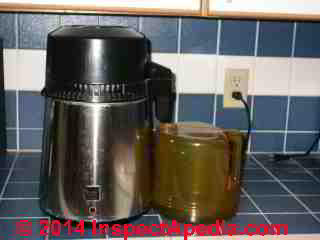 Veggie washes: Bolton et als reported that some vegetable wash products such as Proctor & Gamble's Fit® reduced the level of residual pesticides and bacteria at the same level as using distilled water.
Veggie washes: Bolton et als reported that some vegetable wash products such as Proctor & Gamble's Fit® reduced the level of residual pesticides and bacteria at the same level as using distilled water.
Ozone water purifier systems such as Air Zone's Ozone Water Purifier XT-301 and Indoor Purification Systems' J0-4 Multi-Functional Food Sterilizer removed microbes from the test produce but distilled water was found to be more effective than either of the ozone washes.
Distilled or clean water wash for produce: We have been using the Sears water distiller shown at left to produce distilled water for home use for over twenty years. The product is elegantly simple to operate and produces distilled water suitable for washing vegetables and fruits.
Why does distilled water work well as a produce wash? For two reasons at least:
- Besides not contributing any contaminants itself, distilled water is a very good solvent.
- Important, and on some produce even the dominant contaminants are in dust and soils that are removed by physical washing of the produce.
Advice for using SinBac or similar iodine-based vegetable disinfectant washes
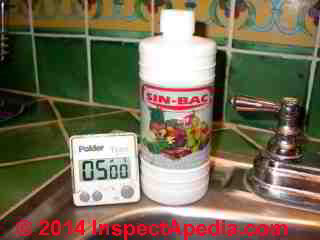 With many years of experience washing locally-grown produce in Mexico we report that failure to wash and disinfect these products can be risky. Typically the products that we have used for at home produce disinfection in Mexico contain iodine.
With many years of experience washing locally-grown produce in Mexico we report that failure to wash and disinfect these products can be risky. Typically the products that we have used for at home produce disinfection in Mexico contain iodine.
Sin-Bac's disinfectant is (Cloro Dimetil Hidantonia or 1-Bromo-3-chloro-5,5-dimethyl-Hydantoin is a mixture of chlorine and bromine to form a useful antiseptic agent having bacteriostatic and bacteriacidal capabilities that have antibacterial, anti fungal, antiprotozoal, and anthelmintic activity) that can be used to disinfect water for drinking.
The Sin-Bac disinfectant concentration requires 4 caps per liter of water for a produce disinfecting wash.
Notice that next to our bottle of Sin-Bac we have a timer set to 5 minutes - the immersion time required for this product. In five years of vegetable wash using this product in central Mexico we have not had a bad result.
Sin-Bac is produced in Mexico by GV Products, Parque Chapultepec No. 61, Col Lomas Del Parque,
- First wash: when disinfecting produce that has visible debris or soil particles we either use tap water or the disinfectant solution from washing cleaner produce items as a first rinse. We've already mentioned the importance of getting mud, dirt, dust off of your produce.
Getting rid of the crud makes the disinfection wash that comes next more effective, safer, more pleasant, and it conserves our disinfecting solution.
You don't need to do a "first wash" if the produce looks clean to the eye. - When disinfecting leafy vegetables that may also be dirty with soil or sand, we rinse them off thoroughly with tap water, or we repeat the disinfection process twice.
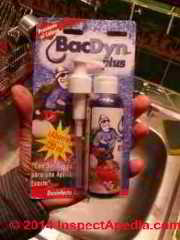 at left is another disinfectant produce wash product, BacDyn Plus (www.bacdyn.com). Unlike the disinfetant-based SinBac, BacDyn Plus uses 0.08% colloidal silver. The manufacturer recommends a 10-minute immersion for produce disinfection. We don't use this product, preferring the Sin-Bac described above.
at left is another disinfectant produce wash product, BacDyn Plus (www.bacdyn.com). Unlike the disinfetant-based SinBac, BacDyn Plus uses 0.08% colloidal silver. The manufacturer recommends a 10-minute immersion for produce disinfection. We don't use this product, preferring the Sin-Bac described above.
The BacDyn concentration instructions are on the package, typically 1/2 capful per liter for a disinfectant wash.
- When disinfecting lettuce we cut the head of lettuce into halves or quarters and immerse the lettuce by placing a dish on top of the vegetables in the soak-bowl during the disinfection period. Lettuce can then simply be drained in a dish drainer before it is stored.
- Don't reduce the disinfection time or solution concentration below that recommended by the manufacturer or you may not be adequately disinfecting your vegetables.
- After vegetables or fruits are disinfected by your solution, do not rinse them off with tap water. Simply let them dry. Rinsing risks re-infecting the food.
- Be sure that the cutting board you use to prepare vegetables or any other food has been thoroughly washed, and in particular, be sure it and your knives are thoroughly cleaned after cutting meat or poultry, before using the same board and knives again to cut and prepare your disinfected vegetables.
- 1-Bromo-3-chloro-5,5-dimethylhydantoin (C5H6BrClN2O2) is produced world-wide and is also used in cleaners and bathroom disinfectants and deodorizers.
Here is an example MSDS for this product, provided
by Leisure Time-MSDS [PDF]
We like the Sin Bac™ product in part because the soak time for vegetables (one cap of disinfectant per liter of water) is just five minutes. Some other vegetable disinfectant solutions require 10 or even 15 minutes of soaking.
Concentration of Iodine or Lugol's Iodine in Vegetable Disinfection& Wash Solutions
Watch out: ... iodophors are not approved for direct food contact. According to the U.S. FDA article cited below, while iodine is commonly used on food contact surfaces and equipment, it is not advised for direct contact use on produce. The article notes (in Table V-1) that the possible usefulness of iodine on some whole produce deserves investigation and that this disinfectant may have significant sporocidal capacity. (U.S. FDA 2016).
More about using iodine as a disinfectant for drinking water is
at IODINE for WATER DISINFECTION.
Research on use of iodine solutions as a vegetable disinfectant
- Bartlett PG, Schmidt W. 1957. Surface-iodine complexes as germicides. Appl Microbiol 5:355-9.
- Bermúdez-Aguirre, Daniela, and Gustavo V. Barbosa-Cánovas. "Disinfection of selected vegetables under nonthermal treatments: chlorine, acid citric, ultraviolet light and ozone." Food Control 29, no. 1 (2013): 82-90.
Abstract:
Lettuce, tomatoes and carrots were evaluated under four disinfection methods. Chlorine (50, 100 and 200 ppm) was compared for effectiveness with citric acid (0.5, 1 and 1.5%), ultraviolet light (UV-C) (0.65 and 1.6 mW/cm2) and ozone (5 ppm) to inactivate Escherichia coli ATCC 11775. Processing times were from 3 min up to 60 min. Hunter color parameters, color functions (ΔE, hue, chroma), tomato color index (TCI) and whiteness index (WI) were evaluated after disinfection. Results showed that citric acid was not effective for inactivation of E. coli at the tested conditions.
UV-C was effective in the inactivation of the microorganism when fluence was higher, being more effective in the smooth surface of tomato (2.7 log). Meanwhile, ozone was also able to inactivate bacteria in tomatoes (2.2 log) after only 3 min. Carrots and lettuce showed lower inactivation for all treatments because of their porous and roughened surfaces.
UV-C was the treatment that most affected the color of the produce; it generated browning of lettuce, and increase of TCI and WI of carrots. Ozone also affected the greenness of lettuce. Concentration, dose and processing times of novel disinfection methods need to be evaluated not only for microbial counts, but also sensory properties.
Highlights:- Inactivation of E. coli was assessed in lettuce, tomatoes and carrots.
- Chlorine disinfection was compared with citric acid, ultraviolet and ozone treatments.
- Ultraviolet and ozone were the most effective methods for tomato disinfection.
- Ultraviolet affected some color parameters in the three evaluated products.
- Disinfection is easier to achieve in smooth surfaces rather than porous or rough surfaces.
- Gottardi, Waldemar. "Iodine and iodine compounds." Disinfection, sterilization, and preservation. Philadelphia: Lippincott Williams & Wilkins (2001): 159-84.
- Gulati, Baldev R., Paul B. Allwood, Craig W. Hedberg, and Sagar M. Goyal. "Efficacy of commonly used disinfectants for the inactivation of calicivirus on strawberry, lettuce, and a food-contact surface." Journal of Food Protection® 64, no. 9 (2001): 1430-1434.
Abstract:
Norwalk and Norwalk-like viruses (NLVs) are important causes of foodborne gastroenteritis in restaurant-related outbreaks. Efficacy of common disinfection methods against these viruses on food-contact surfaces and fresh produce is not known partially because of their nonculturability. Seven commercial disinfectants for food-contact surfaces and three sanitizers for fruits and vegetables were tested against cultivable feline calicivirus (FCV).
Disks of stainless steel, strawberry, and lettuce were contaminated with known amounts of FCV. The disinfectants were applied at one, two, and four times the manufacturer's recommended concentrations for contact times of 1 and 10 min.
The action of disinfectant was stopped by dilution, and the number of surviving FCVs was determined by titration in cell cultures. An agent was considered effective if it reduced the virus titer by at least 3 log10 from an initial level of 107 50% tissue culture infective dose.
None of the disinfectants was effective when used at the manufacturer's recommended concentration for 10 min. Phenolic compounds, when used at two to four times the recommended concentration, completely inactivated FCV on contact surfaces.
A combination of quaternary ammonium compound and sodium carbonate was effective on contact surfaces at twice the recommended concentration. Rinsing of produce with water alone reduced virus titer by 2 log10. On artificially contaminated strawberry and lettuce, peroxyacetic acid and hydrogen peroxide was the only effective formulation when used at four times the manufacturers' recommended concentration for 10 min.
These findings suggest that FCV and perhaps NLVs are very resistant to commercial disinfectants. However, phenolic compounds at two to four times their recommended concentrations appear to be effective at decontaminating environmental surfaces and may help control foodborne outbreaks of calicivirus in restaurants.
Excerpt:
... 75 ppm of titratable iodinec 150 ppm of titratable iodine 300 ppm of titratable iodine ... with FCV and treated with the commonly used antimicrobials for fruits and vegetable rinsing. - Hays H, Elliker PR, Sandine WE. 1967. Microbial destruction by low concentrations of hypochlorite and iodophor germicides in alkaline and acidified water. Appl Microbiol 15:575-81.
- Jilbert WR. 1988. Quality control and sanitation aspects of fresh squeezed citrus juice processing. In: Matthews RF, editor. Food industry short course proceedings. Gainesville (FL): Florida IFT and University of Florida Extension Service.
- Lacey RW. 1979. Antibacterial activity of providone iodine towards non-sporing bacteria. J Appl Bacteriol 46:443-9.
- Mosley EB, Elliker PR, Hays H. 1976. Destruction of food spoilage indicator and pathogenic organisms by various germicides in solution and on a stainless steel surface. J Milk Food Technol 39:830-6.
- U.S. FDA, CHAPTER V. METHODS TO REDUCE / ELIMINATE PATHOGENS FROM PRODUCE AND FRESH-CUT PRODUCE, [PDF], U.S. Food and Drug Administration, U.S. Department of Health and Human Services, retrieved 2016/07/05, original source: http://www.fda.gov/Food/FoodScienceResearch/SafePracticesforFoodProcesses/ucm091363.htm
Excerpt:
2.6. Iodine
Iodophors have a broad spectrum of antimicrobial activity, are less corrosive than chlorine at low temperatures, and are less volatile and irritating to skin than other types of iodine solutions (Lawrence and others 1957). However, iodine-containing sanitizer solutions may be corrosive (upon vaporization above 50 °C [122 °F]), have reduced efficacy at low temperature, and may stain equipment, clothes, and skin.
The use of iodine-containing solutions as direct contact sanitizers for produce is further limited due to a reaction between iodine and starch that results in a blue-purple color. Despite these limitations, iodine solutions such as iodophors (combinations of elemental iodine and nonionic surfactants or carriers) are commonly used as sanitizers for food contact surfaces and equipment in the food processing industry (Bartlett and Schmidt 1957; Hays and others 1967; Mosley and others 1976; Lacey 1979; Jilbert 1988).
Although iodine solutions are not used for direct food contact, a peroxidase-catalyzed chemical solution that included sodium iodide as an antimicrobial constituent was active against salmonellae inoculated onto chicken breast skin (Bianchi and others 1994) and may warrant investigation for some produce items.
As with most sanitizers, iodophors are more active against vegetative cells than bacterial spores. Decimal reduction values for vegetative bacterial cells are between 3 and 15 s at 6 to 13 ppm available iodine at neutral pH (Hays and others 1967; Mosley and others 1976; Gray and Hsu 1979). D values for spores of Bacilllus cereus, Bacillus subtilis, and C. botulinum Type A treated with 10 to 100 ppm of iodophor are 10- to 1000-fold greater than for vegetative cells (Odlaug 1981).
Although iodophors are not approved for direct food contact, they might have some usefulness for treatment of produce items that are peeled before consumption. This type of use would require regulatory approval and a demonstration that produce treated by these compounds are safe for consumption.
Using Hydrogen Peroxide as a Vegetable Wash
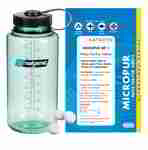 Some websites
describe use of 35% food grade H202 but without citing authoritative sources. "Vegetable
Soak: (CLOROX substitute): Add 1/4 cup of 3% Hydrogen Peroxide into a gallon of Cold Water. Soak light Vegetables (Lettuce, etc.) 20
minutes, thicker skinned Vegetables (like Cucumbers) for 30 minutes.
Some websites
describe use of 35% food grade H202 but without citing authoritative sources. "Vegetable
Soak: (CLOROX substitute): Add 1/4 cup of 3% Hydrogen Peroxide into a gallon of Cold Water. Soak light Vegetables (Lettuce, etc.) 20
minutes, thicker skinned Vegetables (like Cucumbers) for 30 minutes.
Drain and dry, (they keep LONGER too). If time is a Problem, you can spray the Vegetables with straight 3% Hydrogen Peroxide, let stand for a couple of minutes, rinse and dry." But is this treatment effective for just for Ecoli or also for Giardia?
Watch out: Cryptosporidium cysts might survive a typical chlorine disinfection process (such as at a municipal water treatment plant) and these or other cyst-like pathogens are likely to survive casual vegetable washing.
[Click to enlarge any image]
For this reason some municipalities where Cryptosporidium cysts are a concern add a water treatment step using chlorine dioxide.
Others may use a combination of UV light and chlorine in the water treatment procedure. This treatment is also available to hikers, travelers, and for emergency water supply use.
Using Vinegar as a Vegetable Wash
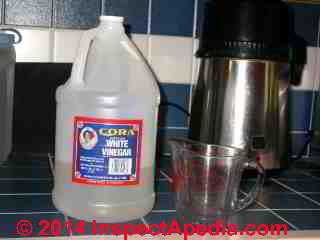 Vinegar produce washing be effective as a limited-scope disinfectant wash for vegetables as well.
Vinegar produce washing be effective as a limited-scope disinfectant wash for vegetables as well.
Rough Calculation: use 1 cup of white vinegar to a large bowl of water; soak clean produce (already washed in fresh clean cold water) for 15 minutes. Do not rinse off the disinfectant solution.
See VINEGAR for PRODUCE or WATER DISINFECTION for details about using vinegar to disinfect produce or drinking water.
Watch out: some sources recommend only a clean water wash for produce but in our view that does not consider sanitary conditions in all situations nor in all countries.
- Sadjjadi, Seyed Mahmoud, Jamshid Rostami, and Mohammad Azadbakht. "Giardiacidal activity of lemon juice, vinifer and vinegar on Giardia intestinalis cysts." (2006).
Abstract The giardiacidal efficacy of simple disinfecting materials, ie lemon juice, vinifer, and vinegar, for uncooked foods with Giardia cysts was investigated to help travelers in Giardia-endemic areas.
The cysts were obtained from stools of individuals with Giardia intestinalis infection by modified sucrose gradient procedure.
A pooled batch of 3 x 10(4)/ml Giardia cysts was made from all specimens. The cysts were kept at 4 degrees C until use. Before each experiment, the number of cysts was determined by hemocytometer. Two sets of Eppendorf tubes were used for the experiments, one set at 4 degrees C and one at 24 degrees C.
One thousand microliters each of lemon juice, vinifer, or vinegar was poured into each tube, and 1,000 microl of Giardia cysts were added. Variables were disinfectant materials, temperature, and time of exposure. Cyst viability 140 was determined by eosin inclusion procedure.
Viability of at least 250 cysts in each tube at 0, 0.5, 1, 2 and 3 hours after the beginning of the experiments was determined. The mean giardiacidal activity at 4 degrees C after 3 hours for lemon juice, viniger, and vinegar was 18.9, 12.8, and 28.4%, and at 24 degrees C, 28.3, 16.2, and 40.6%, respectively.
In conclusion, the giardiacidal activity of vinegar was more than the other materials, and as exposure time and temperature increased, giardiacidal activity also increased; the highest giardiacidal activity of vinegar was at 3-hours exposure at 24 degrees C.
A second useful citation on the effectiveness of vinegar as a disinfectant that can treat giardia is below. Notice that the temperature of the process is important.
- Costa, Adriana Oliveira, Vanete Thomaz-Soccol, Rosangela Clara Paulino, and Edilene Alcântara de Castro. "Effect of vinegar on the viability of< i> Giardia duodenalis cysts." International journal of food microbiology 128, no. 3 (2009): 510-512.
Abstract The inactivation of Giardia duodenalis cysts by vinegar was investigated. Experiments were carried out in 100 ml volume of vinegar (acetic acid 4%), undiluted or diluted in distilled water in ratios of 1:1, 1:15.6, and 1:62.5 (vol/vol), which were inoculated with 5 × 105 cysts obtained from human feces. Experiments were performed at room temperature (21 ± 1 °C) and at 4 °C.
After contact times of 1.5 min, 10, 30, and 60 min, the cysts were recovered from the treatment fluid and subjected to an in vitro excystation assay to determine their viability. The relative viability, which was calculated in relation to controls (maximum excystation percentage), was significantly affected (p < 0.1) by the vinegar concentration, contact time, and temperature.
At 21 ± 1 °C, no cysts remained viable after being treated with undiluted vinegar for 60 min, while the treatment with 1:1, 1:15.6, and 1:62.5 vinegar–water mixtures decreased the relative viability to 1.8%, 19.4%, and 56.4%, respectively.
The relative viability after corresponding treatments at 4 °C also decreased, but 23.6% to 48.8% remained viable after 60 min, and thus complete inactivation was not obtained with any treatment at that temperature.
Other Produce Washes & Disinfectants: alternaties to chlorine
Li (2008) and Ölmez (2009) and certainly other researchers have proposed some alternatives to use of chlorine for disinfecting produce:
The challenge to achieve appropriate disinfection without forming harmful disinfection byproducts by conventional chemical disinfectants, as well as the growing demand for decentralized or point-of-use water treatment and recycling systems calls for new technologies for efficient disinfection and microbial control.
Several natural and engineered nanomaterials have demonstrated strong antimicrobial properties through diverse mechanisms including photocatalytic production of reactive oxygen species that damage cell components and viruses (e.g. TiO2, ZnO and fullerol), compromising the bacterial cell envelope (e.g. peptides, chitosan, carboxyfullerene, carbon nanotubes, ZnO and silver nanoparticles (nAg)), interruption of energy transduction (e.g. nAg and aqueous fullerene nanoparticles (nC60)), and inhibition of enzyme activity and DNA synthesis (e.g. chitosan).
Although some nanomaterials have been used as antimicrobial agents in consumer products including home purification systems as antimicrobial agents, their potential for disinfection or microbial control in system level water treatment has not been carefully evaluated.
This paper reviews the antimicrobial mechanisms of several nanoparticles, discusses their merits, limitations and applicability for water disinfection and biofouling control, and highlights research needs to utilize novel nanomaterials for water treatment applications. - Li (2008)
Ölmez proposes Chlorine dioxide, ozone, organic acids, peroxyacetic acid, electrolyzed oxidizing water and hydrogen peroxide for produce disinfection:
Disinfection is one of the most important processing steps affecting the quality and safety and the shelf-life of the end product in fresh-cut processing. Chlorine is the most widely used disinfectant in fresh-cut industry. However, recent outbreaks associated with pathogen contamination in fresh-cut vegetables raised the concerns about the efficacy of chlorine treatment in assuring the safety of the products.
Moreover, due to the environmental and health risks posed by the use of chlorine, there is a trend in eliminating chlorine from the disinfection process.
Thus, there is a need for alternative sanitizers to be used for the disinfection of fresh-cut vegetables, not only for the organic food sector but also for the conventional food processors. Another challenge for the food industry is the minimization of water consumption and wastewater discharge rates.
The United Nations Environment Programme stated that Europe is one of the two global regions where more water is used for industry than for agriculture. Among the different industries, the food industry ranks third in water consumption and wastewater discharge rates coming after the chemical and refinery industries.
The adoption of less water consuming systems is required for improved water management in the industry. Therefore the food industry is now seeking alternatives to chlorine which assure the safety of the products, maintain the quality and shelf-life, while also reducing the water consumption rates in processing.
Chlorine dioxide, ozone, organic acids, peroxyacetic acid, electrolyzed oxidizing water and hydrogen peroxide are the main alternative sanitizing agents that gained interest in recent years. The effects of these disinfecting agents on the microbiological, nutritional and sensory quality of fresh-cut produce, and also the possible environmental impact and the potential on minimizing water consumption rates in the food industry are reviewed in this manuscript. - Ölmez (2009)
Research: Fruit & Vegetable Produce Disinfection & Soaks, Sprays, Washes
- Driessen, Suzanne, HANDLING FRESH FRUITS AND VEGETABLES SAFELY [PDF] University of Minnesota Extension, retrieved 2022/01/10 original source: https://extension.umn.edu/preserving-and-preparing/wash-fresh-fruits-and-vegetables#don%27t-soak-produce-2019511
- Escudero, María E., Lidia Velázquez, María S. Di Genaro, and Ana María S. De Guzmán. "Effectiveness of various disinfectants in the elimination of Yersinia enterocolitica on fresh lettuce." Journal of Food Protection® 62, no. 6 (1999): 665-669.
- Rose, Joan B., and Theresa R. Slifko. "Giardia, Cryptosporidium, and Cyclospora and their impact on foods: a review." Journal of Food Protection® 62, no. 9 (1999): 1059-1070.
- Rutala, William A., Susan L. Barbee, Newman C. Aguiar, Mark D. Sobsey, and David J. Weber. "Antimicrobial activity of home disinfectants and natural products against potential human pathogens." Infection control and hospital epidemiology 21, no. 1 (2000): 33-38. Abstract
RESULTS. The following compounds demonstrated excellent antimicrobial activity (>5.6‐8.2 log10 reduction) at both exposure times: TBQ, Vesphene, Clorox, ethanol, and Lysol Antibacterial Kitchen Cleaner. Mr. Clean eliminated 4 to >6 logs10 and Lysol Disinfectant ∼4 logs10 of pathogenic microorganisms at both exposure times.
Vinegar eliminated <3 logs10 of S aureus and E coli, and baking soda <3 logs10 of all test pathogens. All tested chemical disinfectants completely inactivated both antibioticresistant and ‐susceptible bacteria at both exposure times. Only two disinfectants, Clorox and Lysol, demonstrated excellent activity (>3 log10 reduction) against poliovirus. - USDA, 4 STEPS to FOOD SAFETY [PDF] retrieved jk2022/01/10 original source: https://www.foodsafety.gov/keep-food-safe/4-steps-to-food-safety
- US FDA 7 TIPS FOR CLEANING FRUITS, VEGETABLES [PDF] U.S. Food & Drug Administration, retrieved 2022/01/10 original source: https://www.fda.gov/consumers/consumer-updates/7-tips-cleaning-fruits-vegetables
- Zander, A., & M. Bunning, GUIDE TO WASHING FRESH PRODUCE [PDF] Colorado State University Extension, Colorado State University, U.S. Department of Agriculture and Colorado counties cooperating. No endorsement of products mentioned is intended nor is criticism implied of products not mentioned - retrieved 2022/01/10 original source: https://nifa.usda.gov/sites/default/files/resource/Guide%20to%20Washing%20Fresh%20Produce508.pdf
Reader Comments, Questions & Answers About The Article Above
Below you will find questions and answers previously posted on this page at its page bottom reader comment box.
Reader Q&A - also see RECOMMENDED ARTICLES & FAQs
On 2020-03-25 by (mod)
Re-posting from private email:
Fruit & Vegetable washing advice for the COVID-19 Pandemic
Fruits and vegetable surfaces are often sticky and may hold onto pathogens. From living in Mexico we learned to wash our fruits and vegetables.
Things that can be washed using dish soap and a scrubby sponge, esp. things with a rind to be cut-off or to be peeled are hand scrubbed.
Examples: canteloupes, watermelons, tomatoes, carrots, oranges, apples (that are also waxed) all can be scrubbed off.
From my reading on bacterial infections on F&V I learned that even using soapy water and physical scrubbing will remove nearly all hazards.
Non-scrubbable fruits and vegetables like grapes, lettuce, cauliflower and broccoli are disinfection-soaked.
In MX we use a 5 minute disinfecting soak in a Sin-Bac soution not easily found in the U.S. But there are easily-prepared disinfection solutions given above on this page.
For example, you can use a vinegar solution to disinfect everything - esp. things that are not going to be individually scrubbed with soap and water by hand - like stringbeans.
Fruit and vegetable disinfection steps:
1. First rinse items thoroughly in clean water. For example we rinse aggressively items like parsley, lettuce, and anything that is likely to hold dust and debris.
2. Second, hand-scrub using dish soap (best an anti-bacterial soap) and a scrubby-sponge, hard items that can be scrubbed clean such as cantaloupe, watermelon, carrots, oranges, apples. Rinse all soap off carefully.
3. Soak non-scrubbables (or everything) in a disinfectant solution such as those described above, for the time recommended - varying by the disinfectant solution chosen, typically 5 minutes.
4. DO NOT rinse off your disinfectant-soaked items, just let them dry in a dish rack.
Note: it's most important to wash off visible mud, dust, debris before cutting or peeling fruits and vegetables. Otherwise your knife may push unsanitary dirt and debris onto the newly-cut surfaces.
On 2016-07-05 by danjoefriedman (mod)
Sheila
As you'll read in the article section above discussing iodine and iodine-type vegetable disinfection approaches,
Watch out: ... iodophors are not approved for direct food contact. According to the U.S. FDA article cited below, while iodine is commonly used on food contact surfaces and equipment, it is not advised for direct contact use on produce. The article notes (in Table V-1) that the possible usefulness of iodine on some whole produce deserves investigation and that this disinfectant may have significant sporocidal capacity. (U.S. FDA 2016).
We discuss iodine as a water disinfectant and concentrations of lugol's solution or Lugol's Iodine in a separate article at
inspectapedia.com/water/Iodine_Drinking_Water_Purification.php
On 2016-07-05 by Sheila
Hello:
I have read that iodine is a powerful disinfectant, also for raw vegetables. but I have never came across for what is the dosage of Lugol's iodine 2% to disinfect vegetables? Could you inform to us more about it? Thanks for your attention and have a great week!
...
Continue reading at VINEGAR for PRODUCE or WATER DISINFECTION or select a topic from the closely-related articles below, or see the complete ARTICLE INDEX.
Or see these
Recommended Articles
- BLEACH DISINFECTANT for DRINKING WATER
- COLLOIDAL SILVER for WATER DISINFECTION - really? well maybe.
- DISINFECTION of BUILDING SURFACES
- DRINKING WATER EMERGENCY PURIFICATION for a complete list of approaches to water and wash disinfection inluding both effective and ineffective methods.
- SEWAGE CONTAMINANTS in FRUIT / VEGETABLES
- VEGETABLE or PRODUCE DISINFECTION
- VINEGAR for PRODUCE or WATER DISINFECTION
- WATER DISINFECTION LIMITATIONS
- WATER DISINFECTANT QUANTITY
Suggested citation for this web page
VEGETABLE or PRODUCE DISINFECTION at InspectApedia.com - online encyclopedia of building & environmental inspection, testing, diagnosis, repair, & problem prevention advice.
Or see this
INDEX to RELATED ARTICLES: ARTICLE INDEX to WATER TREATMENT SYSTEMS
Or use the SEARCH BOX found below to Ask a Question or Search InspectApedia
Ask a Question or Search InspectApedia
Try the search box just below, or if you prefer, post a question or comment in the Comments box below and we will respond promptly.
Search the InspectApedia website
Note: appearance of your Comment below may be delayed: if your comment contains an image, photograph, web link, or text that looks to the software as if it might be a web link, your posting will appear after it has been approved by a moderator. Apologies for the delay.
Only one image can be added per comment but you can post as many comments, and therefore images, as you like.
You will not receive a notification when a response to your question has been posted.
Please bookmark this page to make it easy for you to check back for our response.
Our Comment Box is provided by Countable Web Productions countable.ca
Citations & References
In addition to any citations in the article above, a full list is available on request.
- Arnold, Benjamin F., and John M. Colford Jr. "Treating water with chlorine at point-of-use to improve water quality and reduce child diarrhea in developing countries: a systematic review and meta-analysis." American journal of tropical medicine and hygiene 76, no. 2 (2007): 354-364.
- Bolton, Jason, Bushway, Alfred, Crowe, Kristi, El-Begearmi, Mahmoud, "Best Ways to Wash Fruits and Vegetables", Bulletin $4336, University of Maine, retrieved 4/1/14, original source: http://umaine.edu/publications/4336e/
- Lazarova, V., Ph Savoye, M. L. Janex, E. R. Blatchley III, and M. Pommepuy. "Advanced wastewater disinfection technologies: state of the art and perspectives." Water Science and Technology 40, no. 4 (1999): 203-213.
- Li, Qilin, Shaily Mahendra, Delina Y. Lyon, Lena Brunet, Michael V. Liga, Dong Li, and Pedro JJ Alvarez. "Antimicrobial nanomaterials for water disinfection and microbial control: potential applications and implications." Water research 42, no. 18 (2008): 4591-4602.
- Ölmez, Hülya, and Ursula Kretzschmar. "Potential alternative disinfection methods for organic fresh-cut industry for minimizing water consumption and environmental impact." LWT-Food Science and Technology 42, no. 3 (2009): 686-693.
- Schoenen, D. "Role of disinfection in suppressing the spread of pathogens with drinking water: possibilities and limitations." Water research 36, no. 15 (2002): 3874-3888.
- Shin, Gwy-Am, and Mark D. Sobsey. "Inactivation of norovirus by chlorine disinfection of water." Water research 42, no. 17 (2008): 4562-4568.
- Sobsey, Mark D., Sanitation Water, and World Health Organization. "Managing water in the home: accelerated health gains from improved water supply/prepared by Mark D. Sobsey." (2002).
- U.S. FDA, "Chapter V. Methods to Reduce / Eliminate Pathogens from Produce and Fresh-Cut Produce", [PDF], U.S. Food and Drug Administration, U.S. Department of Health and Human Services, retrieved 2016/07/05, original source: http://www.fda.gov/Food/FoodScienceResearch/SafePracticesforFoodProcesses/ucm091363.htm
- Xu, Xiaoming, Philip S. Stewart, and Xiao Chen. "Transport limitation of chlorine disinfection of Pseudomonas aeruginosa entrapped in alginate beads." Biotechnology and bioengineering 49, no. 1 (1996): 93-100.
- Peter Andrey Smith, "A Quest for Even Safer Drinking Water", The New York Times, 27 August 2013, p. D3
- Mark Cramer Inspection Services Mark Cramer, Tampa Florida, Mr. Cramer is a past president of ASHI, the American Society of Home Inspectors and is a Florida home inspector and home inspection educator. (727) 595-4211 mark@BestTampaInspector.com 11/06
- Hankey and Brown home inspectors, Eden Prairie, MN, technical review by Roger Hankey, prior chairman, Standards Committee, American Society of Home Inspectors - ASHI. 952 829-0044 - hankeyandbrown.com 11/06
- Dr. Omar Amin, of the Tempe AZ Parasitology Center, corresponded with one of our readers asking about peroxide: "You can use hydrogen peroxide if you want to but we do not have a track record of percentage dilution". Dr. Amin has done research for the US military and for the CDC.
- "Bacteria in Drinking Water" - "Chlorine," Karen Mancl, water quality specialist, Agricultural Engineering, Ohio State University Extension. Mancl explains factors affecting the effectiveness of chlorine in water as a means to destroy bacteria and other microorganisms. OSU reports as follows:
Chlorine kills bacteria, including disease-causing organisms and the nuisance organism, iron bacteria. However, low levels of chlorine, normally used to disinfect water, are not an effective treatment for giardia cysts. A chlorine level of over 10 mg/1 must be maintained for at least 30 minutes to kill giardia cysts. -- http://ohioline.osu.edu/b795/index.html is the front page of this bulletin.
- www.epa.gov/ogwdw/mdbp/pdf/alter/chapt_2.pdf provides an article on use of disinfectants for water treatment
- This patent application for UV light sterilization www.patentstorm.us/patents/6565803.html Lists good references on water purification for Giardia et als
- Giardia exposure limits for drinking water: see www.mass.gov/dep/water/drinking/standards/giardia.htm is the current regulatory exposure limit (your minimum target for sterilization)
- Principles and Practice of Disinfection, Preservation and Sterilization (Hardcover)
by A. D. Russell (Editor), W. B. Hugo (Editor), G. A. J. Ayliffe (Editor), Blackwell Science, 2004. ISBN-10: 1405101997, ISBN-13: 978-1405101998.
"This superb book is the best of its kind available and one that will undoubtedly be useful, if not essential, to workers in a variety of industries. Thirty-one distinguished specialists deal comprehensively with the subject matter indicated by the title ... The book is produced with care, is very readable with useful selected references at the end of each chapter and an excellent index. It is an essential source book for everyone interested in this field. For pharmacy undergraduates, it will complement the excellent text on pharmaceutical microbiology by two of the present editors."
The Pharmaceutical Journal: "This is an excellent book. It deals comprehensively and authoritatively with its subject with contributions from 31 distinguished specialists. There is a great deal to interest all those involved in hospital infection ... This book is exceptionally well laid out. There are well chosen references for each chapter and an excellent index. It is highly recommended." The Journal of Hospital Infection.: "The editors and authors must be congratulated for this excellent treatise on nonantibiotic antimicrobial measures in hospitals and industry ... The publication is highly recommended to hospital and research personnel, especially to clinical microbiologists, infection-control and environmental-safety specialists, pharmacists, and dieticians."
New England Journal of Medicine: City Hospital, Birmingham, UK. Covers the many methods of the elimination or prevention of microbial growth. Provides an historical overview, descriptions of the types of antimicrobial agents, factors affecting efficacy, evaluation methods, and types of resistance. Features sterilization methods, and more. Previous edition: c1999. DNLM: Sterilization--methods. - Handbook of Disinfectants and Antiseptics, Joseph M. Ascenzi (Editor), CRC, 1995, ISBN-10: 0824795245 ISBN-13: 978-0824795245 "The evaluation of chemical germicides predates the golden age of microbiology..." -
This well-focused, up-to-date reference details the current medical uses of antiseptics and disinfectants -- particularly in the control of hospital-acquired infections -- presenting methods for evaluating products to obtain regulatory approval and examining chemical, physical, and microbiological properties as well as the toxicology of the most widely used commercial chemicals. - When Technology Fails, Matthew Stein, Chelsea Green Publisher, 2008,493 pages. ISBN-10: 1933392452 ISBN-13: 978-1933392455, "... how to find and sterilize water in the face of utility failure, as well as practical information for dealing with water-quality issues even when the public tap water is still flowing". Mr. Stein's website is www.whentechfails.com/
- "Bacteria in Drinking Water" - "Chlorine," Karen Mancl, water quality specialist, Agricultural Engineering, Ohio State University Extension. Mancl explains factors affecting the effectiveness of chlorine in water as a means to destroy bacteria and other microorganisms. OSU reports as follows:
Chlorine kills bacteria, including disease-causing organisms and the nuisance organism, iron bacteria. However, low levels of chlorine, normally used to disinfect water, are not an effective treatment for giardia cysts. A chlorine level of over 10 mg/1 must be maintained for at least 30 minutes to kill giardia cysts. -- http://ohioline.osu.edu/b795/index.html is the front page of this bulletin.
- Crystal Clear Supply provides portable ceramic water filter purifiers and portable reverse osmosis water treatment equipment - see http://www.crystalclearsupply.com/category_s/7.htm
- Handbook of Disinfectants and Antiseptics, Joseph M. Ascenzi (Editor), CRC, 1995, ISBN-10: 0824795245 ISBN-13: 978-0824795245 "The evaluation of chemical germicides predates the golden age of microbiology..." -
This well-focused, up-to-date reference details the current medical uses of antiseptics and disinfectants -- particularly in the control of hospital-acquired infections -- presenting methods for evaluating products to obtain regulatory approval and examining chemical, physical, and microbiological properties as well as the toxicology of the most widely used commercial chemicals. - Potable Aqua® emergency drinking water germicidal tablets are produced by the Wisconsin Pharmacal Co., Jackson WI 53037. 800-558-6614 pharmacalway.com
- Principles and Practice of Disinfection, Preservation and Sterilization (Hardcover)
by A. D. Russell (Editor), W. B. Hugo (Editor), G. A. J. Ayliffe (Editor), Blackwell Science, 2004. ISBN-10: 1405101997, ISBN-13: 978-1405101998.
"This superb book is the best of its kind available and one that will undoubtedly be useful, if not essential, to workers in a variety of industries. Thirty-one distinguished specialists deal comprehensively with the subject matter indicated by the title ... The book is produced with care, is very readable with useful selected references at the end of each chapter and an excellent index. It is an essential source book for everyone interested in this field. For pharmacy undergraduates, it will complement the excellent text on pharmaceutical microbiology by two of the present editors."
The Pharmaceutical Journal: "This is an excellent book. It deals comprehensively and authoritatively with its subject with contributions from 31 distinguished specialists. There is a great deal to interest all those involved in hospital infection ... This book is exceptionally well laid out. There are well chosen references for each chapter and an excellent index. It is highly recommended." The Journal of Hospital Infection.: "The editors and authors must be congratulated for this excellent treatise on nonantibiotic antimicrobial measures in hospitals and industry ... The publication is highly recommended to hospital and research personnel, especially to clinical microbiologists, infection-control and environmental-safety specialists, pharmacists, and dieticians."
New England Journal of Medicine: City Hospital, Birmingham, UK. Covers the many methods of the elimination or prevention of microbial growth. Provides an historical overview, descriptions of the types of antimicrobial agents, factors affecting efficacy, evaluation methods, and types of resistance. Features sterilization methods, and more. Previous edition: c1999. DNLM: Sterilization--methods. - U.S. Army Field Manual 21-10, Field Hygiene and Sanitation, 1988, web search 07/02/2010, original source: http://www.enlisted.info/field-manuals/fm-21-10-field-hygiene-and-sanitation.shtml
The purpose of this manual is to assist individual soldiers, unit commanders, leaders and field sanitation teams in preventing disease and environmental injuries. The manual provides information on preventive medicine measures (PMM) to the individual soldier as well as essential information for the unit commander, unit leaders, and the unit field sanitation team on applying unit level PMM. - When Technology Fails, Matthew Stein, Chelsea Green Publisher, 2008,493 pages. ISBN-10: 1933392452 ISBN-13: 978-1933392455, "... how to find and sterilize water in the face of utility failure, as well as practical information for dealing with water-quality issues even when the public tap water is still flowing". Mr. Stein's website is www.whentechfails.com/
- Our recommended books about building & mechanical systems design, inspection, problem diagnosis, and repair, and about indoor environment and IAQ testing, diagnosis, and cleanup are at the InspectAPedia Bookstore. Also see our Book Reviews - InspectAPedia.
- In addition to citations & references found in this article, see the research citations given at the end of the related articles found at our suggested
CONTINUE READING or RECOMMENDED ARTICLES.
- Carson, Dunlop & Associates Ltd., 120 Carlton Street Suite 407, Toronto ON M5A 4K2. Tel: (416) 964-9415 1-800-268-7070 Email: info@carsondunlop.com. Alan Carson is a past president of ASHI, the American Society of Home Inspectors.
Thanks to Alan Carson and Bob Dunlop, for permission for InspectAPedia to use text excerpts from The HOME REFERENCE BOOK - the Encyclopedia of Homes and to use illustrations from The ILLUSTRATED HOME .
Carson Dunlop Associates provides extensive home inspection education and report writing material. In gratitude we provide links to tsome Carson Dunlop Associates products and services.


